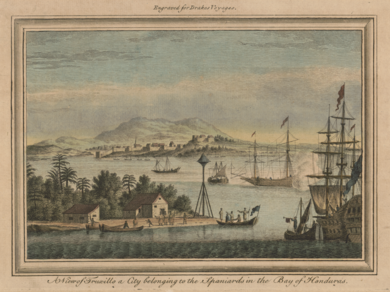Andrew Barker (merchant) facts for kids
Quick facts for kids
Captain
Andrew Barker
|
|
|---|---|
| Born | Before 1570 |
| Died | August 1577 |
| Era | Elizabethan |
| Known for | first Englishman in Bay of Honduras |
| Relatives | John Barker brother |
| Piratical career | |
| Type | Privateer |
| Allegiance | England |
| Years active | 1576–1577 |
| Rank | Captain |
| Base of operations | |
| Commands |
|
Andrew Barker (died 1577) was an English merchant and privateer from Bristol. During the Elizabethan era, privateers were like legal pirates. They had permission from their government to attack and capture enemy ships, especially during times of conflict. Barker is known for being one of the first Englishmen to explore and operate in the Bay of Honduras.
Contents
Andrew Barker's Adventures
Why Did Barker Go on a Voyage?
Andrew Barker and his brother John were merchants from Bristol, England. They often traded with the Spanish in the Canary Islands. This trade was sometimes difficult and led to disagreements.
In 1570, one of their ships, the Falcon, was taken by the Spanish. Its cargo, worth about £2,600, was seized. Many of the crew were also captured.
A few years later, in 1575, another of their ships, the Christopher, was seized near Tenerife. The Spanish took its cargo, worth about £1,700. The captain and crew were only released after paying a large sum of money. These events made Andrew Barker decide to take action. He wanted to get back what he had lost.
Setting Sail for Adventure
To get back what was taken, Barker prepared two ships for a voyage to the West Indies. These ships were the Ragged Staffe, which Barker commanded himself, and the Beare, led by William Coxe. They left Plymouth, England, in May 1576.
Their first stops were the Cape Verde Islands. Here, they traded with local Portuguese residents for food. During their stay, a conflict occurred with some locals. After this, the crew burned two villages before leaving.
Exploring the Seas
Southern Journey
The crew first landed in Trinidad. They were welcomed by the local people and stayed for five days. Next, they sailed near the Isle of Margarita. Here, they captured their first Spanish prize: a ship carrying several tons of wine.
They then stopped at Curaçao for water. Spanish and local residents attacked 14 of Barker's men, injuring them. This forced the crew to leave for the Spanish Main (the mainland coast of the Americas).
After some days, Barker and his master, Philip Roche, had an argument about navigation. Despite their differences, they continued their journey. They sailed to the Bay of Tulu, where they found a small ship. This ship was carrying valuable silver and gold. A Spanish warship later chased them away.
Northern Journey
The Ragged Staffe and the Beare sailed past Nombre de Dios. They headed towards the Chagres River. Barker hoped to meet with Simerons, who were runaway African slaves. He sent ten men upriver, but they returned without success. Many of these men became sick, and several died.
Feeling frustrated, Barker went to Veragua. There, his crew captured another small ship. This ship had some gold, 23 Spanish passengers, and two Flemish people. The Spanish passengers were left on land. The two Flemish people joined Barker's crew. The Ragged Staffe had been leaking, so it was sunk. The captured Veraguan ship took its place.
Following directions from some local people, Barker entered the Bay of Honduras. Here, they surprised a Spanish boat carrying silver and supplies. Its passengers were left on land, except for a Spanish official. He was released only after paying a ransom in gold.
The crew then passed several islands. They arrived at an island called S. Francisco, which is at the entrance of the great Bay of Honduras. At this point, William Coxe and some of the Beare's crew decided to take control. They left Barker and about thirty crewmates stranded on the island.
One morning, sixty Spanish soldiers attacked the stranded crew. Andrew Barker and eight others were killed. Coxe, who was still at the Isle of S. Francisco, took the remaining survivors to another island nearby.
From this safer island, Coxe and his crew decided to raid Trujillo. Some of the crew sailed to the city in a small boat. In Trujillo, they found plenty of wine and oil, but no gold or silver. A Spanish warship soon chased them. Coxe managed to escape, but he lost eight of his men.
The Journey Home
Coxe then set sail for England. About 60 leagues from the Isle of S. Francisco, they faced a terrible storm. They lost valuable treasure, which was swept overboard. Five crewmates and Philip Roche, Barker's former master, drowned.
Finally, the surviving crew arrived at the Isle of Silly, near Cornwall, England, in June 1578. They brought back oil, some cannons, and other items. The treasure they had was divided among the crew. Each person received a share based on what they were thought to have earned.
When they arrived in Plymouth, some of the crew were arrested. Andrew Barker's brother, John, had sued them. He claimed they were responsible for Andrew's death and had betrayed him. Some of the main troublemakers received long prison sentences. Others, though they avoided human law, faced difficult times later on.
Andrew Barker's Place in History
Andrew Barker is thought to be the first English privateer to operate in the Bay of Honduras against the Spanish. His actions came many years before other famous English adventurers like Peter Wallace and the Baymen. This makes his voyage an important part of early English exploration and privateering in the Americas.


